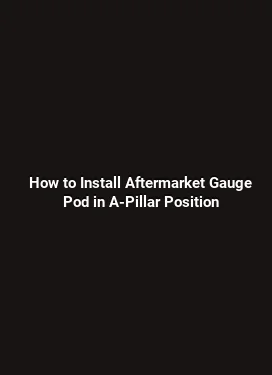Rear Seat Delete Kit Installation: Weight Savings and Cargo Space
Makale içindeki ilk H2 başlık buraya gelmeli

Rear seat delete kits offer a purposeful transformation of a vehicle’s interior by removing the rear seats to reclaim storage potential and reduce overall weight. This mod is popular among enthusiasts who require more cargo room for photography gear, camping equipment, or large purchases, while still preserving the essential safety framework of the car. The decision to install a rear seat delete kit involves evaluating weight distribution, seat belt integration, and how the modification will affect the vehicle’s CG (center of gravity) and overall driving dynamics. Understanding these elements helps ensure the modification serves practical needs without compromising on passenger safety.
In modern vehicles, the rear seating area is often a compromise between passenger comfort and cargo flexibility. A well-executed delete kit maximizes usable space while maintaining a clean, factory-like appearance. The best kits are designed with precision cutouts, high-strength mounting points, and corrosion-resistant hardware to withstand repeated use. When selecting a kit, consider the materials (aluminum, steel, or composite), finish (powder-coated, anodized, or bare metal), and how the attachment points align with factory seat belt anchors and floor anchors. These factors influence both aesthetics and long-term durability.
Understanding the Purpose and Benefits of a Rear Seat Delete
The core purpose of a rear seat delete kit is to convert a two-row interior into a more cargo-focused space while maintaining a safe, organized environment for the remaining components. A well-designed delete can reduce stray weights and improve payload handling for certain applications, such as overland trips, track days with limited passenger needs, or commercial use where bulkier items are transported frequently. The benefits extend beyond simple space reclamation; users often experience better visibility for securing loads, improved modular storage options, and a cleaner, minimalist interior appearance that can be easier to clean and maintain.
It is important to note that a rear seat delete should not compromise key safety elements. High-quality kits accommodate seat belt mounting points and ensure appropriate anchorage for child seats if required by the user’s configuration. Some configurations also integrate optional panels or covers that conceal fasteners and create a seamless look. The result is a practical, aesthetically cohesive interior that prioritizes cargo versatility without creating an inhospitable environment for the driver or other occupants when the rear seats are not needed.
Makale içindeki ilk H3 başlık buraya gelmeli

When evaluating different kit options, look for compatibility with your vehicle’s rail system, floor pan geometry, and the presence of any OEM accessories that may limit or facilitate installation. For example, some kits are designed to reuse existing seat belt anchors and floor clip points, reducing the need for new holes or permanent modifications. Others require minimal drilling and use hardware that mirrors factory standards, ensuring a clean, secure fit. The right kit should provide clear instructions, step-by-step diagrams, and recommended torque specifications to guide the installer through a precise process.
Weight Savings and Cargo Space Impact
Weight savings from a rear seat delete kit vary with the materials used and the overall design. Aluminum-based kits tend to be lighter than steel equivalents, while composite panels may offer additional weight reductions depending on thickness and reinforcement methods. The practical effect of reduced rear seat mass can contribute to slightly improved acceleration, braking response, and potentially better fuel efficiency in some driving scenarios. However, the primary benefit is increased cargo capacity and easier organization of gear, which can translate into measurable improvements in daily usability and payload management.
From a cargo space perspective, removing the rear seats expands the footprint behind the front row. This enables longer items to fit flat on the cargo floor, reduces the need to fold or bend items to accommodate width, and allows for more modular storage solutions such as containers, dividers, and draw systems. For vehicles that frequently carry bulky equipment—camera gear, camping supplies, or automotive tools—a rear seat delete can unlock a more efficient loading workflow. It is essential to account for load security; with the seats removed, securing points, tie-down hooks, and non-slip mats become more critical to prevent shifting and potential damage during transit.
Makale içindeki ilk H3 başlık buraya gelmeli
To balance weight savings with functionality, some users opt for partial deletions or modular systems that retain a portion of the seat structure for occasional passenger use. This approach may involve removable panels or lightweight brackets that can be reinstalled if the need arises, preserving resale value and flexibility. When considering modular options, evaluate how easy it is to revert to stock configuration, the time required for switching, and whether any restrictions apply under warranty terms or insurance coverage.
Materials, Fitment, and Durability
Material choice directly affects durability, weight, and finish quality. Aluminum alloys offer a strong yet lightweight solution, often complemented by stainless steel fasteners to resist corrosion and the harsh conditions encountered in vehicle interiors. Steel provides ultimate strength but adds weight, which may offset some weight-saving goals. Composite panels can deliver excellent rigidity with further reductions in mass, though they may require careful mounting to prevent flex under load. A high-quality kit will incorporate corrosion-resistant coatings, such as powder coatings or anodized finishes, to withstand humidity, temperature fluctuations, and abrasion from cargo handling.
Fitment accuracy is critical for both safety and user experience. Kits that are precisely machined to align with the vehicle’s floor pan, seat belt anchors, and trim contours deliver a factory-like appearance. Ill-fitting components can cause rattles, gaps, and uneven panel surfaces that detract from the interior’s polished feel. Before purchase, verify compatibility with your specific make, model, and year, and check for user reports on fitment across similar configurations. A well-fitting kit should also include weather seals or edge protection to guard against dust, moisture, and friction between moving parts.
Makale içindeki ilk H3 başlık buraya gelmeli
Durability testing and real-world use scenarios help gauge long-term performance. Look for kits that demonstrate load testing in the areas of panel mounting, fastener retention, and edge endurance under repeated installations and removals. Some manufacturers provide warranty coverage that reflects confidence in durability, which can be a meaningful factor when weighing options. Additionally, consider the impact on cabin acoustics; high-quality installations minimize panel rattle and reduce cabin noise, maintaining a comfortable driving environment even with expanded cargo space.
Tools, Preparation, and Installation Steps
Preparation is the foundation of a clean, reliable installation. Start by gathering the necessary tools, which typically include metric wrenches or a socket set, Torx drivers, a torque wrench, protective gloves, and, for some kits, a rubber mallet or soft-faced hammer to avoid scuffing edges. It is wise to have a flashlight or portable work light, a floor mat or blanket to protect interior surfaces, and a magnetic tray to keep fasteners organized. Before removing any components, carefully review the kit’s manual and take reference photos of anchor points and wiring routes to aid reassembly if needed.
The step-by-step process generally follows these phases: disconnect the battery if there are any electrical interfaces involved; remove trim panels surrounding the rear seating area to access mounting points; detach seat cushions and remove or temporarily secure them according to the kit instructions; install any substructure or brackets to the floor pan or existing anchors; attach the delete panels, ensuring alignment with door sills and trim pieces; re-secure any trims and floor mats; and finally perform a functional check to confirm all fasteners are tight and panels sit flush without interfering with door movement or seat belt operation.
Makale içindeki ilk H3 başlık buraya gelmeli
During installation, manage clip avoidance and careful routing of any belt or cargo tie-down components. Some kits include dedicated channeling for seat belt retraction paths to prevent interference. It is common to use thread-locking compounds on threaded fasteners to maintain securing strength, especially in a vehicle that experiences vibration and temperature variation. After assembly, test-fit various cargo configurations to ensure there is no binding against door frames or seat rails when loading or unloading items.
Safety Considerations and Reversibility
Safety remains a central pillar of any interior modification. A properly installed delete kit should preserve critical crash structure boundaries, seating anchor points, and occupant protection features. If the kit alters seat belt mechanism geometry, it must be clearly documented, and the installation should not hinder the function of the remaining restraint system components. For families or vehicles used for passenger transport, choosing a reversible solution is prudent. Reversibility options include removable panels, quick-release hardware, or a design that allows reinstalling the rear seats with minimal tools and time.
In addition to structural safety, consider fire safety and electrical considerations. Ensure that any wiring harnesses, fuse boxes, or electronic modules located under the rear seats do not become exposed or misrouted after installation. It is advisable to perform a basic post-install inspection after the first long trip to verify that there are no loose components and that load-bearing surfaces maintain their integrity under V2 (vehicle-to-load) stress scenarios.
Makale içindeki ilk H3 başlık buraya gelmeli
Some enthusiasts opt for a lightweight panel to cover the former seat area instead of a full delete, balancing a cleaner look with a non-permanent interior change. This approach can provide a compromise between space and returnability, preserving the option to revert to stock configuration with minimal downtime. When adopting reversible strategies, document mounting points and keep original hardware in a labeled container to facilitate quick reassembly when needed.
Maintenance, Comfort, and Interior Integration
Post-install maintenance focuses on keeping the cargo area clean and ensuring that all fasteners remain secure. Regular inspections every few thousand miles or after significant trips (e.g., overland expeditions or long-haul drives) help identify any loosening of brackets or trim panels. Cleaning the delete area with a soft brush and mild cleaner reduces the accumulation of dust and debris that can affect panel fit and overall aesthetics. For drivers who spend extended periods in the cabin, attention to airflow and insulation around the cargo area can improve comfort by reducing cabin temperature differentials that might arise from changes in interior geometry.
Interior integration is another key area. A seamless look is achieved when delete panels match the existing interior color and texture. Even small details, such as edge finishes and screw head visibility, can influence perceived quality. Some kits provide optional trim caps or color-matched fasteners to enhance the visual harmony between the delete area and the rest of the cabin. Thoughtful integration not only improves daily usability but can also positively influence resale value by maintaining a cohesive interior aesthetic.
Compatibility Across Models and Alternatives
Compatibility is not universal. Each vehicle platform has unique floor pan geometry, belt anchorage patterns, and trim profiles that influence whether a particular delete kit will fit without modification. Before purchasing, verify model year, trim level, and any factory options that might affect installation. Some platforms benefit from aftermarket solutions that incorporate modular design or hybrid configurations, allowing partial deletions with minimal impact on the vehicle’s electronics or safety systems. If the intent is to use the vehicle for mixed roles—daily driving with occasional cargo hauling—consider a kit that is easily reversible and does not permanently alter the seating footprint.
Alternatives to a full rear seat delete include partial deletions, modular cargo flooring with integrated dividers, or collapsible storage systems that mount to the existing floor anchors. These options provide a balance between cargo flexibility and passenger carriage, offering a scalable approach that can adjust to changing needs over time. When evaluating options, assess the ease of future reinstatement, the potential for warranty implications, and the availability of OEM-recommended accessories that align with your vehicle’s design language.
Makale içindeki ilk H3 başlık buraya gelmeli
In practice, many owners adopt a phased approach: begin with a partial deletion to test fit, monitor real-world usage, and then decide whether to expand the modification. This strategy minimizes risk and helps preserve resale value by ensuring that any changes can be reversed with relative ease. Documentation, photos, and notes about fastener torque and alignment become valuable references if a future owner wants to discontinue the modification or if service needs arise.
Aesthetic, Ergonomic, and Practical Tips
Beyond function, aesthetics and ergonomics play a crucial role in how satisfying a rear seat delete feels in daily use. Positive touches include a snug panel fit with minimal gaps, consistent color and texture with the surrounding trim, and the presence of protective edging to prevent scuffing against cargo. Ergonomics matter as well; ensure there is clear, unobstructed access to the cargo area from both sides of the vehicle, and verify the cargo floor remains comfortable to stand on when loading heavy items. For pet owners, consider the impact on space for carriers or crates and how to secure them without creating trip hazards.
In terms of trend-conscious design, the growing popularity of modular cargo systems and lightweight materials aligns with the broader shift toward efficiency and customization. Integrating a delete kit with a modular storage setup can maximize versatility while maintaining a clean, organized cabin. The use of anti-slip mats, cargo nets, and labeled storage bins helps users quickly adapt the space to different tasks, underscoring the practical value of the modification beyond mere weight reduction.
Conclusion: Real-World Implications and Next Steps
Installing a rear seat delete kit is more than a simple weight-reduction exercise; it is a strategic interior transformation that expands cargo capabilities, enhances organization, and can improve daily practicality for specific use cases. By choosing a kit with precise fitment, durable materials, and thoughtful integration, vehicle owners can reap meaningful benefits without compromising safety or long-term reliability. The key lies in a well-planned approach that prioritizes compatibility, reversible options, and meticulous installation practices that protect the vehicle’s integrity and maintain a refined interior appearance.
Frequently Occurring Considerations and Practical Takeaways
Understanding the trade-offs between cargo space and passenger capacity helps buyers align expectations with real-world needs. A robust, well-executed rear seat delete can dramatically improve load carrying ability for weekend adventures or professional use while preserving the essential safety framework. When considering a modification of this nature, engage with reputable installers, review installation manuals in detail, and inspect the final job for alignment, finish quality, and secure fastening. Thoughtful planning, careful execution, and ongoing maintenance collectively ensure that the finished interior delivers lasting value and daily usability.






